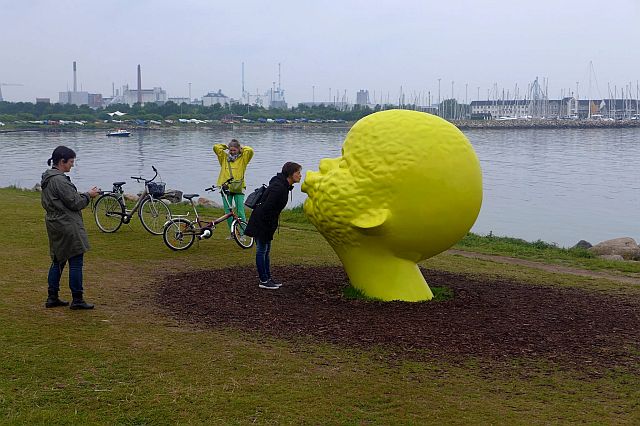
SEASIDE SCULPTURE. A visitor kisses one of 40 large sculptures displayed at an annual “Sculptures by the Sea” exhibit on the Aarhus bay. (CDN PHOTO/JASON BAGUIA)
“Aarhus and the 18 other municipalities in Central Denmark Region celebrate our year as European Capital of Culture in 2017.” —www.aarhus2017.dk
FROM 2014 to 2015, I lived in Aarhus, a small harbor city that is Denmark’s second largest where I finished half of graduate school. In 2017, together with Pafos in Cyprus, Aarhus will be Europe’s “Capital of Culture.”
Here are some things I like about this city.
I
Infirmaries are not only for the sick. A garden thrives by Aarhus Universitetshopital along the street named Skanderborgvej. Here, a healthy you can look, in summer or autumn at sunflowers big and round as normal chocolate cakes or just sit on a bench and admire other blooms from marigolds to early spring’s forget-me-nots. If lucky, you will be entertained by a lunging hare. If uppity, do not panic at sudden movement in the brush. It just happens to be the hideout to big, fat pigeons startled by your approach.
II
You can travel far back in time. The city’s brick-and-mortar and steel-and-glass buildings are linear, rather modern, but the crypt underneath the sanctuary of Vor Frue Kirke by Vestergade road has been standing since around the first millennium.

OLD TOWN CHRISTMAS. The best time to visit Dem Gamle By or Aarhus’ old town is Christmas, when the season’s decorative lights stand in for the sun
that sets by mid-afternoon. (CDN PHOTO/JASON BAGUIA)
Archaeologists acknowledge it as the oldest underground church in Scandinavia. Sit here and enjoy the interplay of shadow and light on the stone floors, archways and columns as the day progresses. Contemplate the mysteries of faith while looking at a Viking-style crucifix. Keep quiet. Others sit and pray in the shadows.
III
There are deer in the neighborhood, in Marselisborg Dyrhave, a reservation next to the sea that is like a preview of Eden in terms providing for human-forest animal interaction. When it is not wintry, you can visit, pet, feed and take pictures with the endearing bucks, does and fawns. Bring some apples and carrots with you. The animals have become so accustomed to humans feeding them they will tail you in expectation of food. Take care to keep them away when it is time for you and your companions to use a picnic table.
IV
The beach can be an art gallery. For a few weeks in summer, the leading makers of large installation art showcase grand sculptures by the sea, and they are not only for ocular inspection. There are pieces you can walk on, enter, climb or even kiss. Each certainly serves as an interesting, colorful accent to landscape and seascape and offer new perspectives of an already beautiful promenade.
DEER PARK. Young deer like moving as a herd especially when on the lookout for food-bearing visitors in this popular Aarhus reservation. (CDN PHOTO/JASON BAGUIA)
V
To this day, a miraculous spring flows in Sankt Nikolaus’ Kildepark, a clearing bordered by trees and wild berries between bay and road at Marselis Boulevard’s west end. Long ago, Saint Niels Knudsen, a love child of the Danish King Canute V joined some Aarhus residents in cutting down trees to build a church. In the middle of work, one man said he felt thirsty. The saint prayed for water and a spring gushed forth from the earth in answer to his petition. The spring has been flowing ever since. Spring and park are maintained by the city as a cultural landmark.
SILENT SPRING. The writer took this
overhead view of Saint Niels’ Spring, miraculously flowing fresh waters
flowing close to the sea in Aarhus
on a celebration of All Saints’ Day. (CDN PHOTO/JASON BAGUIA)
VI
Den Gamle By or The Old Town is a postcard come alive, particularly at Christmastime. Come here on an afternoon in December and step into an
enclave of houses from generations past populated by life-size wax figures of Danes knitting, chopping wood, cooking, cobbling shoes, going about simple everyday lives. Take care as you walk past shops selling artisans’ products from soap to greeting cards. You may need to pause and step aside when you meet a grand, horse-drawn carriage. Stop by the fires to warm yourself when you feel too cold. The outdoors are a sight to behold with pastel-colored houses reflected on still ponds and Christmas trees shining clearer and clearer under the indigo sky.

